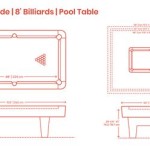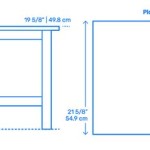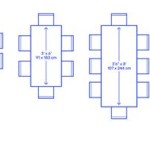Table Tennis Size in Feet
Table tennis, also known as ping pong, is a popular sport played by millions around the world. It is a fast-paced and exciting game that requires quick reflexes, hand-eye coordination, and strategic thinking. The game is played on a rectangular table with a net dividing it into two halves. The dimensions of the table are standardized to ensure fair play and consistency across competitions. This article will delve into the specifics of the table tennis table size in feet, explaining the different dimensions and their significance.
Table Dimensions
A standard table tennis table is 9 feet long, 5 feet wide, and 2.5 feet high. These dimensions are mandated by the International Table Tennis Federation (ITTF), the governing body for the sport. The table is divided into two equal halves by a net that is 6 feet long and suspended 6 inches above the playing surface. The net posts should be 3 feet high, ensuring that the net hangs at a consistent height across the table.
Significance of Table Dimensions
The standardized dimensions of the table tennis table play a crucial role in the game. They provide a consistent playing area, allowing players to develop their skills and strategies without the variability of different table sizes. The dimensions influence the speed and trajectory of the ball, the angles of play, and the strategic options available to players.
For instance, the length of the table provides ample space for players to cover ground and retrieve shots. The width restricts the movement of the ball, making it necessary for players to position themselves strategically to return shots. The height of the table determines the bounce height of the ball, influencing the timing and speed of shots. The net height adds an element of challenge, forcing players to execute shots with precision to clear the net.
Importance of Standardization
Standardization in table tennis table dimensions is particularly crucial for international competitions where players from different countries and backgrounds compete against each other. The same standardized dimensions promote fairness, ensuring that all players have an equal opportunity to compete on a level playing field.
Furthermore, the standardized dimensions help to maintain consistency in the game, facilitating a smooth flow of play and making judgments easier for officials. It also allows for the development of consistent equipment and playing techniques, promoting a globally recognized sport with shared rules and traditions. The standardized table dimensions have played a vital role in the growth and popularity of table tennis as a global sport.
Additional Considerations
While the standardized dimensions are essential for official competitions, there are also recreational tables available in various sizes. These tables are typically smaller and may not meet the ITTF standards, but they are suitable for casual play and practice. The size and quality of the table can also influence the bounciness of the ball, which impacts the style of play.
Understanding the table tennis table dimensions is essential for players, coaches, and officials. The standardized dimensions ensure fair play, promote consistency, and contribute to the global appeal of the sport. Whether playing competitively or for leisure, the table dimensions play a vital role in defining the dynamics and strategy of the game.

How To Choose Your Table Tennis

Table Tennis Dlgsc

To Choose The Right Table Tennis Size For You Stiga Sports

Ping Pong Table Dimensions Ponghero

A Comprehensive Guide To Ping Pong Table Dimensions
To Choose The Right Table Tennis Size For You Stiga Sports

Folding Table Tennis Size Dimensions Cornilleau

Table Tennis Size In Feet Board Drawing

Understand The Table In Tennis On Opponent S Size There Is 4 5 Feet Depth And Wide That Mean You Have Higher Chance Of Winning To

About Table Tennis Rsscpc Com








